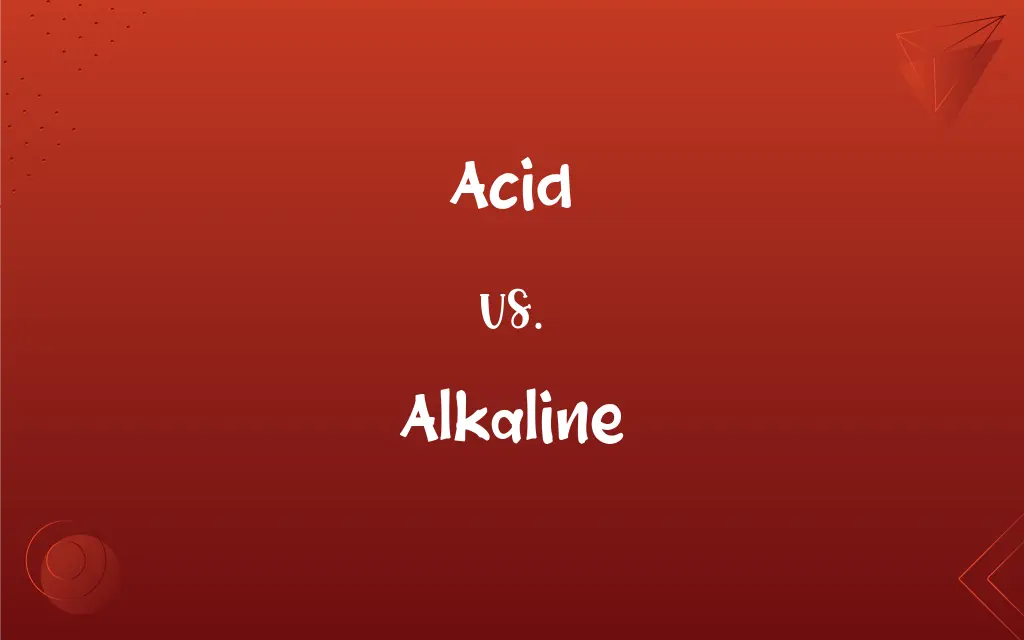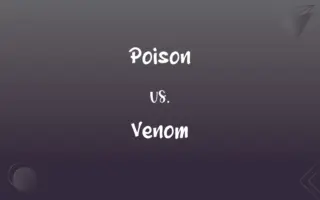Acid vs. Alkaline: What's the Difference?
Edited by Aimie Carlson || By Harlon Moss || Updated on October 18, 2023
Acid is a substance that donates protons or H+ ions; alkaline refers to a base that can accept H+ ions and has a pH above 7.

Key Differences
An acid is a substance that can donate protons or hydrogen ions, whereas an alkaline substance refers to bases that have the ability to accept these hydrogen ions.
In the pH scale, which measures the acidity or alkalinity of a solution, acids have a pH less than 7, while alkaline solutions have a pH greater than 7.
Acids generally taste sour and can turn blue litmus paper red, whereas alkaline substances, on the other hand, often taste bitter and turn red litmus paper blue.
When acids and alkaline substances combine, they can neutralize each other, producing salt and water as a result.
In terms of reactivity, strong acids can be corrosive and react violently with certain metals, while strong alkaline solutions can be caustic and harm organic tissue.
ADVERTISEMENT
Comparison Chart
Proton Activity
Donates protons or H+ ions
Accepts H+ ions
PH Value
Less than 7
Greater than 7
Taste
Sour
Bitter
Reaction with Litmus
Turns blue litmus paper red
Turns red litmus paper blue
Reactivity
Can be corrosive, especially strong acids
Can be caustic, especially strong bases
ADVERTISEMENT
Acid and Alkaline Definitions
Acid
A substance that donates hydrogen ions.
Lemon juice contains citric acid, giving it a sour taste.
Alkaline
A base that can accept hydrogen ions.
Baking soda has alkaline properties, making it useful for neutralizing acid.
Acid
A solution that turns blue litmus paper red.
Vinegar turned the blue litmus paper red, confirming it's an acid.
Alkaline
A substance with a pH value above 7.
Soap solutions are typically alkaline in nature.
Acid
A compound with a pH value below 7.
Soda is acidic due to the carbonic acid it contains.
Alkaline
A substance that can neutralize acids.
Adding an alkaline substance to acid can help in neutralizing the reaction.
Acid
A substance that can neutralize bases.
Adding an acid to a base can produce salt and water.
Alkaline
A solution that turns red litmus paper blue.
The cleaning solution turned the red litmus paper blue, indicating its alkaline nature.
Acid
A molecule capable of forming covalent bonds with electron pairs.
Sulfuric acid is a strong acid used in various industrial processes.
Alkaline
A term used to describe basic solutions in water.
The water from the spring was alkaline, benefiting certain plants.
Acid
Any of a class of substances whose aqueous solutions are characterized by a sour taste, the ability to turn blue litmus red, and the ability to react with bases and certain metals to form salts.
Alkaline
Of, relating to, or containing an alkali.
Acid
A substance that yields hydrogen ions when dissolved in water.
Alkaline
Having a pH greater than 7.
FAQs
What do acids typically taste like?
Acids typically have a sour taste.
Can acids conduct electricity?
Yes, when dissolved in water, many acids can conduct electricity.
How can one identify an alkaline substance using litmus paper?
An alkaline substance will turn red litmus paper blue.
What happens when an acid and an alkaline substance mix?
They can neutralize each other, typically producing salt and water.
What color does red litmus paper turn in an alkaline solution?
In an alkaline solution, red litmus paper turns blue.
What are the health risks of handling strong alkaline substances?
Strong alkaline substances can be caustic, leading to skin burns or eye damage upon contact.
What common household substance is an acid?
A common household acid is vinegar.
Can acids react with metals?
Yes, many acids can react with metals, releasing hydrogen gas.
What happens to the pH when an alkaline solution is diluted?
When an alkaline solution is diluted, its pH typically decreases but remains above 7.
Is it correct to use the term alkaline interchangeably with basic?
Yes, in the context of pH and solutions, alkaline is often used interchangeably with basic.
Can acids neutralize alkaline solutions?
Yes, acids can neutralize alkaline solutions, and vice versa.
Are alkaline waters beneficial for health?
While some claim health benefits, there's limited scientific evidence supporting significant benefits of alkaline water.
Can acids and alkaline solutions be found in foods?
Yes, many foods can be acidic (like citrus fruits) or alkaline (like spinach).
Can acids corrode certain materials?
Yes, especially strong acids can corrode certain metals and materials.
How can alkaline substances benefit health?
Some believe alkaline foods can balance body pH and promote health, but scientific evidence is mixed.
Is vinegar an acid or alkaline?
Vinegar is acidic due to the presence of acetic acid.
Do alkaline batteries contain a basic or acidic electrolyte?
Despite the name, alkaline batteries have a basic (alkaline) electrolyte.
What is the pH range of alkaline substances?
Alkaline substances have a pH range greater than 7.
Are all acids harmful to the skin?
No, not all acids are harmful, but strong acids can cause burns and irritation.
Are citrus fruits acidic or alkaline?
Citrus fruits are acidic due to the presence of citric acid.
About Author
Written by
Harlon MossHarlon is a seasoned quality moderator and accomplished content writer for Difference Wiki. An alumnus of the prestigious University of California, he earned his degree in Computer Science. Leveraging his academic background, Harlon brings a meticulous and informed perspective to his work, ensuring content accuracy and excellence.
Edited by
Aimie CarlsonAimie Carlson, holding a master's degree in English literature, is a fervent English language enthusiast. She lends her writing talents to Difference Wiki, a prominent website that specializes in comparisons, offering readers insightful analyses that both captivate and inform.































































